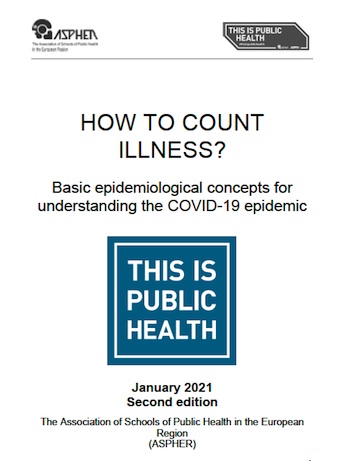**New** Second Edition of How to Count Illness now available!
How to Count Illness: Basic epidemiological concepts for understanding the COVID-19 epidemic is a useful handbook of epidemiological terms aimed at giving journalists and the general public a better understanding of what we mean when public health talks about COVID-19. How to Count Illness has been translated into multiple languages in order to make it useful across many different country contexts in the European Region (see below).
Forward to How to Count Illness

There are over a hundred definitions of epidemiology. The one I use is “the study of disease in populations”. It's simple and easy to remember….
Epidemiologists will probably question if it’s right… There has never been a greater interest in epidemiology than right now in the COVID-19 pandemic. There are have-a-go epidemiologists from all walks of life – people who use numbers for a living – mathematicians, statisticians, geographers, philosophers computer programmers, even accountants and quantity surveyors can be found showing their insights on the twitter sphere. There is some brilliant stuff out there, and new ways of presenting data hopefully giving us all new knowledge to keep people safe and stop the spread of this terrible virus. Our major newspapers have built up extensive repositories of data often shared for free, sometimes ahead of academic institutions and national governments. And in the common parlance, who would have imagined three months ago we would all be talking “epidemiology”, “R0”, “Rt”, ”prevalence”, “incidence”, “predictive value” and many more terms. But we must also encourage our politicians and public to get beyond a superficial understanding of the terms they are using and recognise some of the pitfalls, misconceptions and potential errors inherent in what we do.
It is necessary for us all to understand what we mean by these terms. Colleagues in the Association of Schools of Public Health in the European Region (ASPHER) – the oldest Association of Public Health – represent the great teaching engines of public health in Europe and beyond. This rapidly constructed compendium will hopefully help journalists, business consultants, other stakeholders and also members of the general public to develop their knowledge and expand the power of citizen science. We are all citizens of the world now, and we must all play our part in controlling and preventing the further spread of this pandemic.
I commend this glossary to epidemiology to you all.
John Middleton President ASPHER
** The Second Edition of How to Count Illness is now available! Including updated graphics and additional definitions.**
Download How to Count Illness, 2nd Edition here (English version)
Translated versions (2nd edition):
Download How to Count Illness, 1st Edition here (Original English Version).
Translated versions (1st Edition):
Arabic
French
Georgian
German
Hebrew
Italian
Portuguese
Romanian
Spanish





